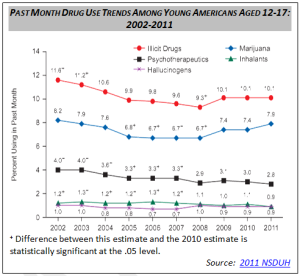Marijuana: Will Legalizing Cause More Harm Than Good?
Marijuana thrives in the US under a smoky veil of contradictions. Its introduction by Mexican immigrants during the early 1900’s as a recreational stimulant sparked fears of cultural degradation.
During the Great Depression, as citizens competed against illegal immigrants for jobs in a failing economy, these same fears escalated into a national consensus against illegal immigrants and their “evil weed” (pbs.org).
In 1936, a French director named Louis Gasnier produced the film “Reefer Madness,” which solidified the conservative view on marijuana as a social plight, causing harm to individuals who smoke and to the rest of society by its broader consequences. The La Guardia report, a later study released by the New York Academy of Medicine, concluded that marijuana was much less harmful than earlier research indicated. Despite this debate (and maybe because of it), marijuana has permeated American culture. As the people continue to vote for its legalization and decriminalization, the lawmakers and those charged with upholding the laws scramble to keep step to a dance in which they are unfamiliar.
An example of current laws and their inability to keep pace with the growing acceptance of marijuana use are those aimed at DUIs (Driving Under the Influence). We look to the frontier of the movement, Colorado, to see the problems that arise while enforcing DUI laws that involve a legal substance that causes driving impairment. Currently, Colorado law allows drivers to operate vehicles with up to 5 nanograms of THC (delta-9-tetrahydrocannabinol) in their system. Critics of this allowance claim that it is an arbitrary number that results in unfair arrests and unsafe drivers on the roads. According to the Huffington Post, inexperienced users of pot will demonstrate a far greater level of impairment at 5 nanograms of THC than an experienced user. Concerns also arise for those users who ingest the THC in an edible form, such as candy or cookies. The level of THC consumed from these products is much higher than when the plant is smoked. For this reason, Colorado’s DUI laws unfairly punish those who may be medically unable to smoke and who rely on the edibles for medical use, since current methods for measuring THC are able to measure amounts-but not actual levels of impairment.
Sgt. John Clawson of the Chambersburg Police Department identifies another problem with DUI enforcement when marijuana is involved. “In order for us to arrest someone for a DUI of marijuana we must use a D.R.E. (Drug Recognition Expert). Field Sobriety tests are not conclusive when it comes to marijuana impairment and the courts want to see a D.R.E.’s assessment in addition to the hospital’s blood tests,” says Clawson.
Currently, the Chambersburg police force has one officer who is trained as a D.R.E. and the Pennsylvania state police department employs two. Clawson says that the intensity of the training and the time it requires to complete is a deterrent for many officers. He says that the loss of manpower due to the training and the expenses for travel and accommodations limit the number of DREs in many states, including Colorado.
Cpl. Daren Helsel of the Chambersburg Police Department worries that if marijuana is legalized in PA, the costs relating to DUI enforcement are only one of many budget concerns that police officers will face. He questions advocates’ arguments that money from legal marijuana sales will benefit the local economy.
“Everyone talks about the money that will be brought in from taxes and sales, but few are talking about the expenses of regulating this new industry. Who will patrol the areas around the dispensaries to ensure safety? Who will answer the calls reporting that someone has broken into a home and stolen someone’s marijuana? Just like the problems associated with prescription medicine, people will steal instead of getting prescriptions or buying it,” says Helsel.
Another argument against the economic benefits of making weed legal is the effects of corporatization on the new industry. According to a White House press release, the price of marijuana could drop as much as 80 percent from its current street price. A drop in price means an increase in use, especially for young people who may have been unable to afford the habit prior to its legalization. Legalizing marijuana places a dual burden on the government of regulating a new market while continuing to pay for the negative side effects of an underground market and an unsafe drug.
In addition to inadequate laws and harmful economics, the matter of social implications must be considered when advocating for marijuana legalization. Are there not enough means to dull one’s self and escape life’s troubles already? Advocates claim that a responsibly regulated industry will not advertise to impressionable youth and that parents should take personal charge of keeping such products locked up and safely away from children. Officers Clawson and Helsel doubt that this approach is realistic. They refer to the current trend of alcohol and prescription medicine abuse as an example of parent irresponsibility.
Legalizing marijuana presents many good points for debate, but these last few are the most important. As the drug becomes easily accessible and cheap, what will happen to our youngest citizens? Will the smell of freshly burnt weed replace the smell of mom’s meatloaf in their childhood memories? Or maybe after years of smoking marijuana or exposure to secondhand smoke they will not be able to remember anything at all.
